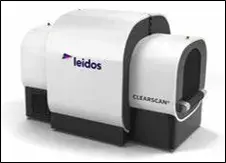This summer, the Science and Technology Directorate (S&T) demonstrated a new advanced algorithm to better detect non-explosive weapons like guns, knives, and other items that are prohibited on commercial aircraft in a real-world setting at Las Vegas’ McCarran International Airport.
The Automatic Prohibited Item Detection (APID) machine learning algorithm—funded by S&T’s Screening at Speed Program—is intended to complement existing Transportation Security Officer (TSO) procedures to enhance and accelerate detection of non-explosive prohibited items. Once operational, it could lead to less direct TSO intervention and fewer secondary screenings, improving efficiency and passenger throughput.
 In late August, TSA’s Office of Requirements and Capability Analysis began a study at McCarran’s Innovation Checkpoint, which provides a flexible evaluation environment for emerging security technologies at an active airport security checkpoint. At McCarran, the nation’s seventh busiest airport by passenger volume, TSA partners with facility officials to control the flow of travelers to Innovation Checkpoint lanes without disrupting the flow of operations and while maintaining transparency to travelers.
In late August, TSA’s Office of Requirements and Capability Analysis began a study at McCarran’s Innovation Checkpoint, which provides a flexible evaluation environment for emerging security technologies at an active airport security checkpoint. At McCarran, the nation’s seventh busiest airport by passenger volume, TSA partners with facility officials to control the flow of travelers to Innovation Checkpoint lanes without disrupting the flow of operations and while maintaining transparency to travelers.
Following a 2017 Broad Agency Announcement competitive proposal-and-selection process, S&T’s Screening at Speed Program selected Reston, Virginia-based Leidos Corporation to develop the algorithm to meet TSA’s technology priorities as outlined in the agency’s capability maturation roadmap. Multiple cycles of development and refinement were conducted by Leidos and S&T in close coordination with TSA to maximize opportunities for the technology’s transition at the project’s completion.
“Consistent coordination and collaboration with our TSA partners significantly increase S&T’s ability to produce transition-ready technologies that address the agency’s priorities and seamlessly fit into their checkpoint concept of operations,” said Sharene Young, S&T’s TSA Portfolio Manager. “The APID algorithm was developed with TSA’s priorities in mind, and we’re excited to see the results of the demonstration at the Innovation Lanes.”
Leidos developed and matured the algorithm through traditional methods, including training with thousands of labeled images to teach the algorithm the difference between prohibited and non-prohibited items. A review of the algorithm’s maturation this summer revealed encouraging preliminary results. TSA opted to study the algorithm in an operational environment to gain feedback from TSOs and evaluate the effectiveness of the proposed concept of operations. The study ran for two weeks and feedback will inform future requirements, including user interface improvements and additional algorithm maturation.
Current operations require TSOs to manually review each computed tomography (CT) X-ray image of carry-on bags and personal belongings at the checkpoint. During the study, the algorithm flagged CT scans that might contain potential threats, providing the TSO a second set of “eyes” during manual review. Once certified and qualified as capable of meeting detection and operational standards by TSA, the APID algorithm is designed to integrate with CT X-ray scanners already in operation at airports across the country as well as with certified explosives detection algorithms. APID will provide TSOs an all-in-one, high-resolution view of carry-on bags and will flag potential threats. Once operational, it should significantly reduce the need for manual reviews, improve overall TSO effectiveness, and speed up passenger throughput at security checkpoints.
“The long-term goal for the APID algorithm is to better identify which passenger carry-on bags are cleared and which have potential threats, to significantly reduce the amount of time required to review images of each bag and bin of personal items, reduce the number of secondary screenings, and increase traveler throughput at checkpoints,” said S&T Screening at Speed Program Manager Dr. John Fortune. “Using machine learning algorithms to create rapid inspection processes at the nation’s airport checkpoints will not only improve overall security, but boost TSO screening efficiency and cognitive load and enhance traveler satisfaction with the airport security-screening experience.”
The Screening at Speed Program pursues transformative research and development to increase aviation security effectiveness from curb to gate while dramatically reducing wait times and improving the passenger experience. To enable this vision, the program invests in and manages the development of solutions to transform the aviation screening concept of operations, in line with TSA requirements and priorities. Developing automated detection algorithms promises to move operations closer to next-generation operations where passengers move more quickly through airports, screening continues to meet and exceed TSA’s high standards, detection is impacted less by human capabilities, and TSOs manage screenings with fewer direct interventions.
Now that the demonstration has concluded, the effort will move on to certification and qualification of the algorithm through testing and maturation. Once complete, this automatic detection algorithm will be a critical piece in the Screening at Speed vision for a seamless travel experience, where most passengers are able to breeze through a checkpoint, TSOs act primarily in a customer service role, and inspections are only necessary when the system identifies an anomaly. Positive improvements of this nature will increase air traveler satisfaction and overall security.
For related media requests, contact STMedia@hq.dhs.gov.
